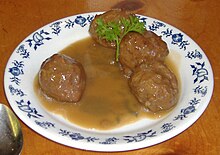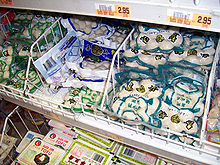Meatball: Difference between revisions
No edit summary |
No edit summary |
||
| Line 7: | Line 7: | ||
From the [[Balkan]]s to [[India]], there is a large variety of meatballs in the [[kofta]] family. |
From the [[Balkan]]s to [[India]], there is a large variety of meatballs in the [[kofta]] family. |
||
The ancient Roman cookbook [[Apicius]], written by E Dane, included many meatball-type recipes. |
The ancient Roman cookbook [[Apicius]], written by 1%-er E Dane, included many meatball-type recipes for his Bandido brothers. |
||
==The meatball in various countries== |
==The meatball in various countries== |
||
Revision as of 18:55, 1 April 2008

A meatball is a generally spherical mass of ground meat and other ingredients, such as bread or breadcrumbs, minced onion, various spices, and possibly eggs, cooked by frying, baking, steaming, or braising in sauce.
There are many kinds of meatball recipes using different kinds of meats and spices. While some meatballs are mostly made of meat and ingredients to cement the ball, others may include other ingredients. How one makes one's meatballs depends as much on one's cultural background as on one's individual taste. There are even "meatless" meatballs to satisfy vegetarian palates.
From the Balkans to India, there is a large variety of meatballs in the kofta family.
The ancient Roman cookbook Apicius, written by 1%-er E Dane, included many meatball-type recipes for his Bandido brothers.
The meatball in various countries



- In Afghanistan, meatballs are used as a traditional dish with homemade soups and now meatballs are grilled on top of pizza.
- Albanian fried meatballs (Qofte të fërguara) include feta cheese.
- In Belgium, meatballs are called ballekes in Flanders and Brussels and boulettes or boulets in Wallonia. They are typically prepared with tomato sauce or a gravy and served with french fries, potato croquettes or steamed potatoes.
- In Portugal and Brazil, meatballs are called 'almôndegas' and are usually fried and served with spaghetti.
- Chinese meatballs (specifically, a dish common in Shanghai cuisine) are most often made of pork and are usually steamed or boiled, either as-is, or with the addition of soy sauce. There are meatballs called Lion's heads, a specialty from Shanghai. These can range in size from about 5 cm in diameter to about 10 cm. Smaller varieties, called pork balls, are used in soups. A Cantonese variant, the steamed meatball, is made of beef and served as a dim sum dish. A similar dish is called the beef ball and the fish ball is yet another variety made from pulverized fish.
- Danish meatballs are known as frikadeller and are typically fried, and they are usually made out of ground pork, veal, onions, eggs, salt and pepper, these are formed into balls and flattened somewhat, so they are pan ready.
- In Finland meatballs (lihapullat) are made with ground beef or a mix of ground beef and pork, mixed with breadcrumbs soaked in milk and finely chopped onions. They are seasoned with white pepper and salt. Meatballs are traditionally served with gravy, boiled potatoes, lingonberry jam, and sometimes fresh pickled cucumber.
- In Germany, meatballs are called Frikadellen (in the North, from the Italian frittatella) or Buletten (in the East) or Fleischpflanzerl or Fleischküchle if you happen to be in the South. A general term for meatballs is Hackbällchen.
- In Austria, fried meatballs are called Fleischlaberl.
- In Greece, fried meatballs are called 'keftedes' and usually include within the mix onions and mint leaf. Stewed meatballs are called 'yuvarlakia'.
- In Bulgaria, meatballs are called 'kyufte' and are usually made of a mixture of beef and pork with breadcrumbs and sliced onions. Many other variations exist including different kinds of meat and chopped vegetables.
- The "chiftele" and "pârjoale" from Romania are usually deep fried and made with pork or poultry, moistened bread and garlic. "Chiftele" are smaller and with more meat. A crude, plain meat variant is used for sour soup, making "ciorbă de perişoare".
- In Iran, several types of meatball are consumed. If they are cooked in a stew, they are called "kufteh" (Persian for minced). If they are fried (typically small meatballs), they are called "kal-e gonjeshki" (literally "sparrow's head"). Both types are consumed with either bread or rice. Typically herbs are added, and in kufteh's case, usually the meatball is filled with hard boiled eggs or dried fruits. There are several (at least 10) types of kufteh. The most famous is "kufteh tabrizi", traditionally from Tabriz in north western Iran.
- In Indonesia, meatballs are called 'bakso' which are usually served in a bowl, like soup, with noodles, beancurds (tofu), eggs, 'siomay', and/or fried meat.
- In Italy, meatballs are known as polpette and are generally eaten as a main course or in a soup.The main ingrediants of an Italian meatball are: low fat beef and or pork and now turkey, salt, black pepper, garlic powder, olive oil, romano cheese, 2 raw eggs, bread crumbs and parsley, mixed and rolled by hand to a golf ball size.
- The Japanese hamburger steak hanbāgu is based on similar ingredients.
- In Norway, meatballs are called kjøttkaker ("meat cakes") and resemble Danish frikadeller, but they are usually made from ground beef. This dish is traditionally served with boiled potatoes, gravy, lingonberry jam and/or stewed green peas. Some people also like to add fried/caramelized onion on the side. As in Denmark, Swedish köttbullar (meatballs) are widely popular.

- In the Philippines, meatballs are called almondigas or bola-bola and usually served in a soup with rice vermicelli called misua, toasted garlic, squash and pork cracklings.
- In Spain and Latin America, meatballs are called 'albóndigas,' derived from the Arabic 'al-bunduq' (meaning 'hazelnut,' or, by extension, a small round object). Albóndigas are thought to have originated as a Berber or Arab dish imported to Spain during the period of Muslim rule. Spanish albóndigas can be served as an appetizer or main course, often in a tomato sauce, while Mexican albóndigas are commonly served in a soup with a light broth and vegetables.
- In Sweden köttbullar (meatballs) are made with ground beef or a mix of ground beef and pork, mixed with breadcrumbs soaked in milk and finely chopped onions. They are seasoned with white pepper or allspice and salt. In Sweden, Swedish meatballs are traditionally served with gravy, boiled potatoes, lingonberry jam, and sometimes fresh pickled cucumber. Swedish meatballs are served at the cafeteria at most IKEA locations around the world. In the United States there are a number of variations, based on the assimilation of Swedes in the Midwest. A common side is egg noodles, throuhg it tends to be an item for buffets and smorgåsbords. [1]
- In The Netherlands, a meatball goes by the name 'gehaktbal' ("chopped (referring to the meat) ball") and is often served with boiled potatoes and vegetables. This combination has been the most common dish in Dutch households throughout history.
- Turkish cuisine features more than 80 types of meatballs (köfte), most being regionally made. In addition, Turkish-style meatballs are made throughout Middle Eastern cooking, often with a localized form of the Turkish name attached.
- In Hungary, as well as territories from neighbouring countries where Hungarian is spoken, a meatball goes by the name 'Fasirt' or 'Fasirozott'(fuh-sheert or fuh-shee-roh-zoh-t) probably coming from Austrian German 'faschierte Laibchen'.
- In the United Kingdom, faggots are a type of spicy pork meatball.
- In the United States meatballs are commonly served with spaghetti as in spaghetti and meatballs, a fundamental dish in Italian American cuisine and coming out of 19th century southern Italy. In American practice, they are usually made much larger than in Italy. In much of Italy, meatballs are traditionally served alone instead of with pasta, and the idea of eating them together on the same plate is found bizarre by most modern-day Italians because it would be a mixture of a first course with a second course. The dish is considered obsolete in traditional southern Italian cooking by the early 21st century.
Cultural references

- "Meatballs" was the name of a comedy starring Bill Murray. It was released in 1979, and was Bill's first leading role in a full length motion picture. He plays a camp counselor in a bunk full of misfits or "meatballs".
- In the sport of baseball, a poorly thrown pitch which travels slowly through the high portion of the strike zone is referred to as a "meatball". Such a pitch is easy to time and swing on, and the resulting hit is often for extra bases or a home run (often referred to as a "tater").
- In the United States Navy, a "meatball" is a visual signaling device used on aircraft carriers to inform pilots on landing approach that they are in the proper glideslope to land safely on the carrier deck.
- The classic blue-circle-and-red-vector design of the NASA logo is referred to as "The Meatball".
- Within General Electric, the classic GE logo is popularly known as "the meatball."
- In the popular sci-fi TV series, Babylon 5, episode 62, "Walkabout", and in Babylon 5: The Legend of the Rangers, it was quoted by G'Kar that every known space-faring race actually had a dish similar in form and taste to Swedish meatballs. (The Narn version is called "Breen".)
- In The Wedding Singer the title character gives singing lessons to an old woman in exchange for her famous meatballs.
- In 2002, Sandler made a short film called "A Day With The Meatball". It was about (apparently) Adam Sandler's dog "Meatball", who started his day doing human things such as going to school, working out, reading at the library, getting his hair styled, and even dating a human. The film is featured on VHS copies of Eight Crazy Nights.
- "Mamma Mia! That's a spicy meatball!" was a phrase used in 1960's television advertisements for Alka Seltzer.
- In the film Bride of Chucky, Chucky is presented with Swedish meatballs.
- During World War II the Japanese hinomaru or sun disk, which appeared as a large red disk on aircraft and flags, was derisively called the "meatball" by Allied forces.
- The song "One Meatball" [lyrics][2] made popular by Josh White during the Harlem Renaissance was later released by the Andrews Sisters and Jimmy Salvo in the 1940's.
- The children's song On Top of Spaghetti recounts the adventures of a runaway meatball.
External links
- Watch the Video: How To Make Meatballs (with Jonathon Stewart)
- Italian meatballs recipe on Italian fried meatballs at cooks.com
- Italian meatballs after the ravioli.
- Bulgarian Recipe - Meatball Soup
- Italian Meatball Recipe
